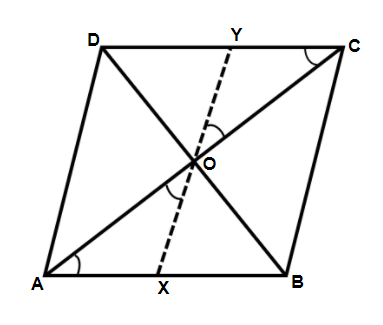
The diagonals of a parallelogram ABCD intersect at O. A line through O intersects AB at X and DC at Y. Prove that $OX=OY$.
Answer
509.7k+ views
Hint: We will first of all construct a neat and clean diagram with proper labels to proceed in our question. Now, to prove $OX=OY$, we would need to prove the congruence of the two triangles containing OX and OY. So, the first step should be to prove the congruence of triangles OAX and OCY. We shall proceed in this manner to get the validation of our proof.
Complete step by step answer:
It has been given that the ends of the parallelogram are A, B, C and D respectively. Also, a line through O intersects AB at X and DC at Y. Now, we have enough information required for the construction of our parallelogram. This parallelogram can be constructed as follows:

Now, we can see in the above figure that, to prove $OX=OY$, we need to prove the congruence of $\vartriangle OAX\text{ and }\vartriangle OCY$. This can be done as follows:
In the triangles OAX and OCY, we have:
$\Rightarrow \angle AOX=\angle COY$
This is true by the property of opposite angles subtended between two-line pairs.
Now, we have:
$\Rightarrow OA=OC$
This is true because diagonals of a parallelogram bisect each other.
And, at last we have:
$\Rightarrow \angle OAX=\angle OCY$
This is true by the property of alternate interior angles of two parallel lines.
Therefore, using these three equations, we can apply the angle-side-angle (ASA) postulate of congruence. Thus, we can write:
$\Rightarrow \vartriangle OAX\cong \vartriangle OCY$
Therefore, now we can say that:
$\Rightarrow OX=OY$
Hence, $OX=OY$ has been proved for parallelogram ABCD.
Note: Proper construction and labelling of diagrams is very important when going for a proof in mathematics. It helps us see things and data more clearly. So, the diagram should always be neat. Also, one should be very careful in using the correct postulate while proving congruence of two triangles.
Complete step by step answer:
It has been given that the ends of the parallelogram are A, B, C and D respectively. Also, a line through O intersects AB at X and DC at Y. Now, we have enough information required for the construction of our parallelogram. This parallelogram can be constructed as follows:

Now, we can see in the above figure that, to prove $OX=OY$, we need to prove the congruence of $\vartriangle OAX\text{ and }\vartriangle OCY$. This can be done as follows:
In the triangles OAX and OCY, we have:
$\Rightarrow \angle AOX=\angle COY$
This is true by the property of opposite angles subtended between two-line pairs.
Now, we have:
$\Rightarrow OA=OC$
This is true because diagonals of a parallelogram bisect each other.
And, at last we have:
$\Rightarrow \angle OAX=\angle OCY$
This is true by the property of alternate interior angles of two parallel lines.
Therefore, using these three equations, we can apply the angle-side-angle (ASA) postulate of congruence. Thus, we can write:
$\Rightarrow \vartriangle OAX\cong \vartriangle OCY$
Therefore, now we can say that:
$\Rightarrow OX=OY$
Hence, $OX=OY$ has been proved for parallelogram ABCD.
Note: Proper construction and labelling of diagrams is very important when going for a proof in mathematics. It helps us see things and data more clearly. So, the diagram should always be neat. Also, one should be very careful in using the correct postulate while proving congruence of two triangles.
Recently Updated Pages
Master Class 10 General Knowledge: Engaging Questions & Answers for Success

Master Class 10 Science: Engaging Questions & Answers for Success

Master Class 10 Social Science: Engaging Questions & Answers for Success

Master Class 10 Maths: Engaging Questions & Answers for Success

Master Class 10 English: Engaging Questions & Answers for Success

Master Class 10 Computer Science: Engaging Questions & Answers for Success

Trending doubts
The shortest day of the year in India

Why is there a time difference of about 5 hours between class 10 social science CBSE

Write a letter to the principal requesting him to grant class 10 english CBSE

What is the median of the first 10 natural numbers class 10 maths CBSE

The Equation xxx + 2 is Satisfied when x is Equal to Class 10 Maths

State and prove converse of BPT Basic Proportionality class 10 maths CBSE




